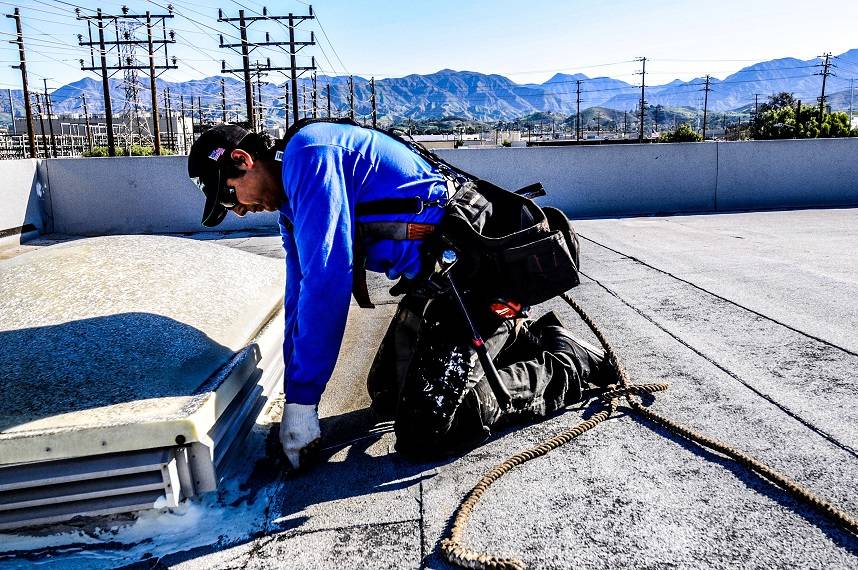Schedule Free Estimate
5 Crucial Ways El Niño Can Impact Health, Food, The Economy and Your Commercial Roof
In case you haven’t heard El Niño 2023 has already started and there are many ways it could affect our lives.
El Niño for those of you who don’t know, is a climate phenomenon characterized by the periodic warming of ocean waters in the central and eastern tropical Pacific Ocean. It can have widespread effects on weather patterns and ecosystems around the world. Here are five ways El Niño could impact health, food, the economy, and even your roof:
-
El Niño Health Impacts:
- Heat Waves and Heat-Related Illnesses: El Niño can lead to higher temperatures in many regions, resulting in heatwaves that can increase the risk of heat-related illnesses and even deaths, especially among vulnerable populations such as the elderly and those with preexisting health conditions.
- Spread of Vector-Borne Diseases: Altered rainfall patterns during El Niño can create breeding grounds for disease-carrying mosquitoes and other vectors. This can lead to increased transmission of diseases like malaria, dengue fever, and Zika virus.
-
Food Impacts:
- Crop Failures and Reduced Agricultural Productivity: El Niño can disrupt normal precipitation patterns, leading to droughts in some areas and excessive rainfall in others. This can negatively impact crop yields and reduce agricultural productivity, leading to food shortages and higher prices for staple foods.
- Fisheries Disruptions: The warming of ocean waters during El Niño can disrupt marine ecosystems and affect fish migration patterns, potentially leading to reduced fish catches and impacting the livelihoods of fishermen and seafood industries.
-
Economic Impacts:
- Agricultural Losses: Crop failures and reduced agricultural productivity can lead to financial losses for farmers and related industries, affecting the overall economy of a region or country.
- Infrastructure Damage and Repair Costs: Increased rainfall during El Niño can lead to flooding, landslides, and other natural disasters that damage infrastructure such as roads, bridges, and buildings. The cost of repairing this damage can strain government budgets and impact local economies.
-
Commercial Roof and Housing Impacts:
- Structural Damage: Excessive rainfall as as expected for us here in Los Angeles, and strong winds associated with El Niño events can cause damage to roofs, gutters, and other parts of houses and buildings leading to leaks and structural issues.
- Mold Growth: Increased humidity and moisture from heavy rains can create conditions conducive to mold growth, which not only damages the structural integrity of buildings but can also pose health risks to occupants.
-
Water Supply and Management:
- Water Scarcity and Droughts: El Niño can lead to drought conditions in certain regions, reducing water availability for drinking, agriculture, and other essential needs.
- Water Quality Issues: Changes in precipitation patterns and runoff during El Niño can affect water quality by carrying pollutants into water sources, potentially impacting human health and ecosystems.
Conclusion
El Niño’s influence extends across multiple sectors. The economic ramifications, ranging from agricultural losses to infrastructure damage, emphasize the need for resilient strategies to counter its impacts. The building and housing structures that shelter us can face challenges, as roofs especially commercial roofs suffer damage from extreme weather events. It’s important that we prepare our roofs, implement adaptive measures, and collectively work towards a more resilient and sustainable future as we brace for what El Niño has in store for us.
Central Roofing Company Headquarters
555 W. 182nd Street
Gardena, CA 90248
310-527-6770

Get A Quote
One of our roofing estimators will gladly meet you to discuss your options and follow up with a free, no-obligation, written estimate.
At Central Roofing Company, we understand that a sturdy and reliable roof is crucial for the success and safety of your commercial property. Our team of highly skilled and trained roofing professionals is committed to delivering exceptional craftsmanship and superior service in every project we undertake.
555 W. 182nd St. Gardena, CA 90248
Ph: 310-527-6770
Our Office Locations:
Our Services
CA license #684960 – Central Roofing, 2024 ©All Rights Reserved | Terms of Use | Privacy Policy | Built by Dymic